Unit 4 Body Language Using Language 课件 (共29张)-高中英语人教版(2019)选择修必修第一册 (共31页PPT)
文档属性
| 名称 | Unit 4 Body Language Using Language 课件 (共29张)-高中英语人教版(2019)选择修必修第一册 (共31页PPT) | 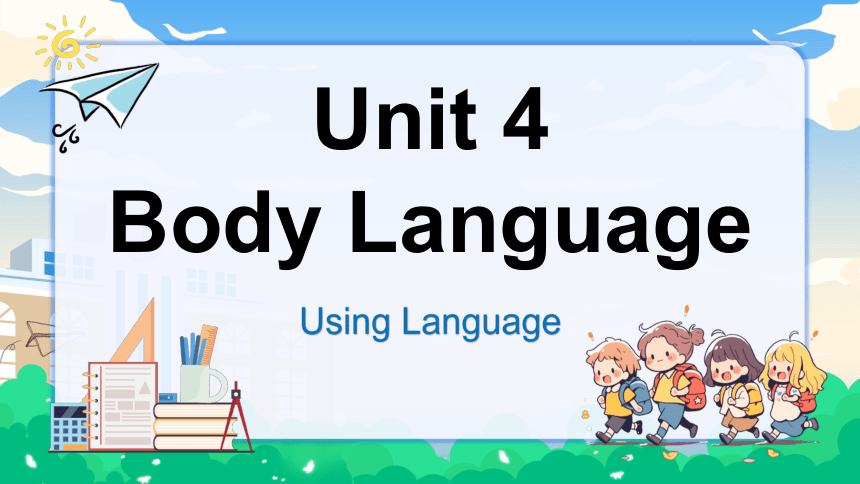 | |
| 格式 | pptx | ||
| 文件大小 | 5.1MB | ||
| 资源类型 | 教案 | ||
| 版本资源 | 人教版(2019) | ||
| 科目 | 英语 | ||
| 更新时间 | 2025-05-27 21:13:06 | ||
图片预览

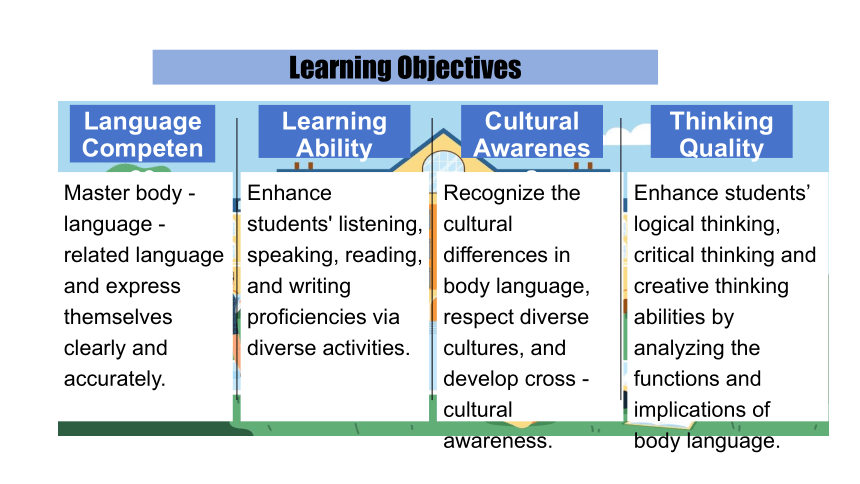
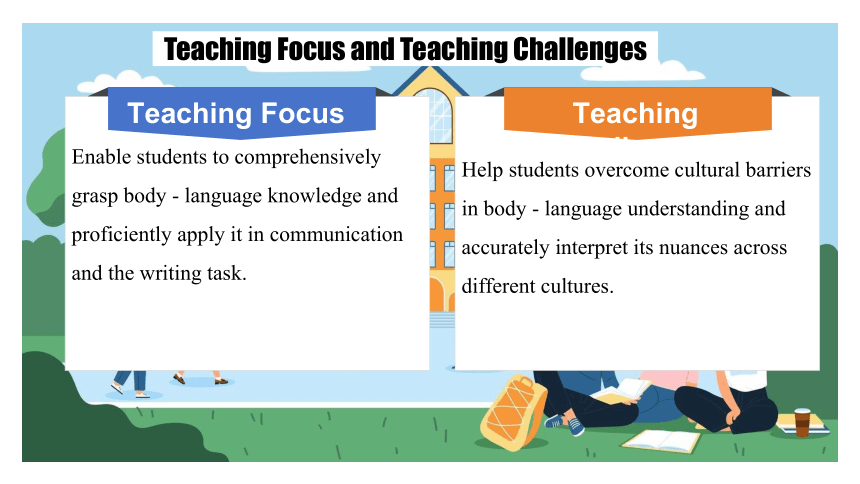
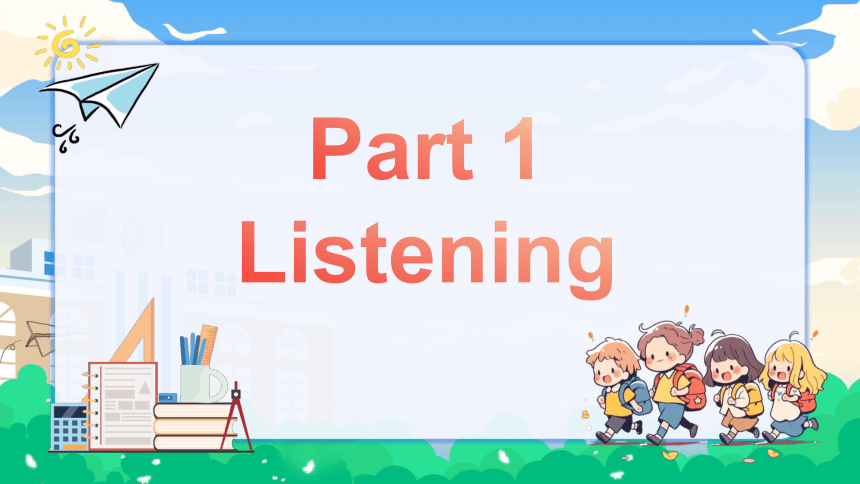
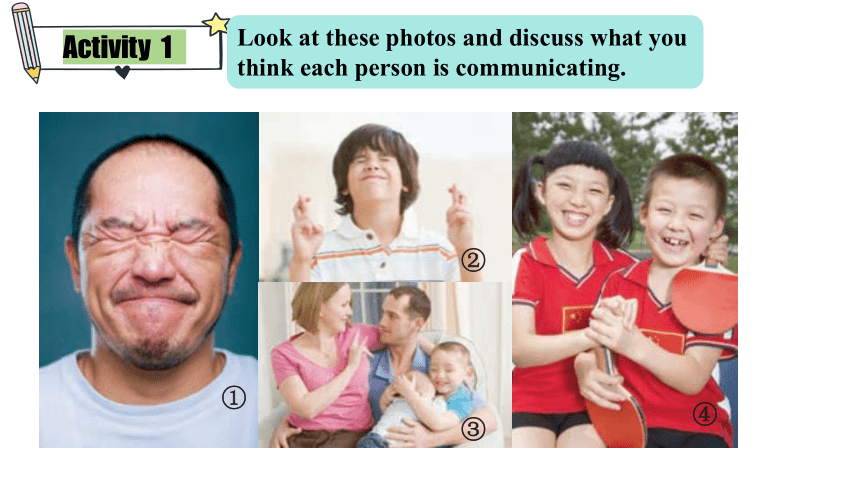
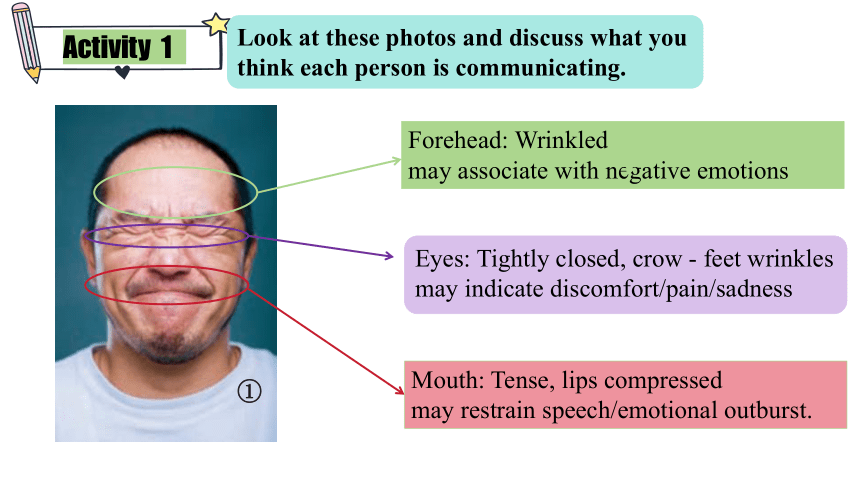
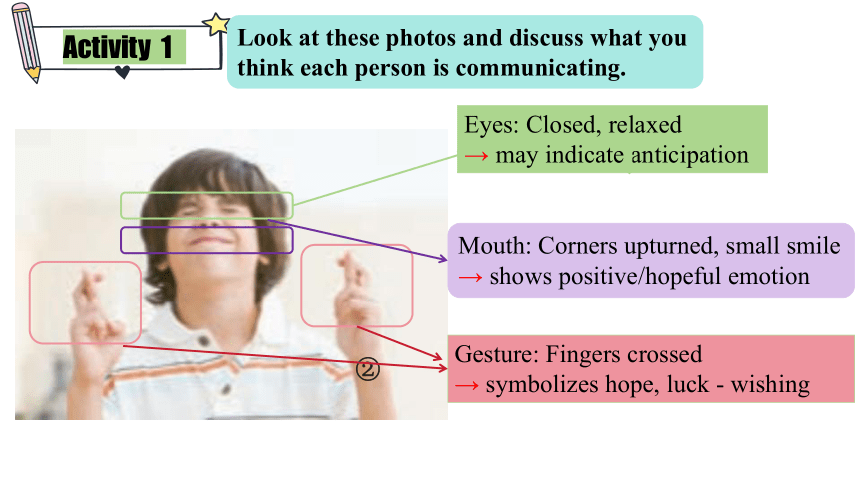
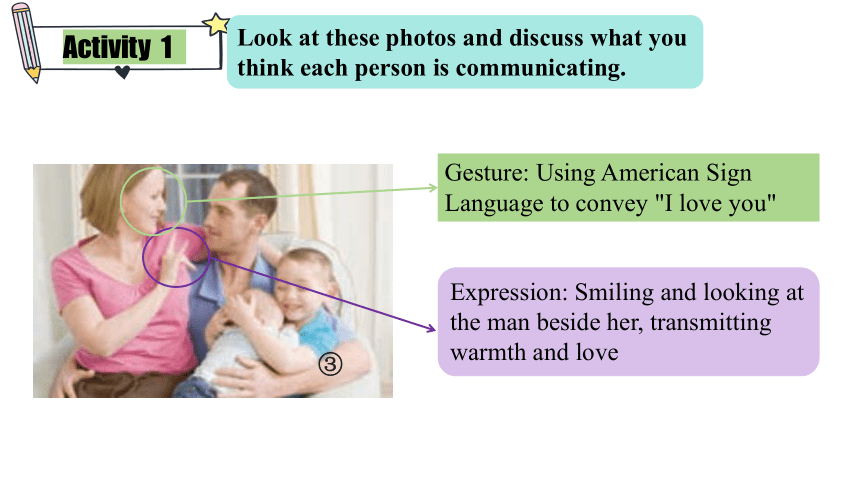

文档简介
(共29张PPT)
Unit 4
Body Language
Using Language
Language Competence
Master body - language - related language and express themselves clearly and accurately.
Learning Ability
Enhance students' listening, speaking, reading, and writing proficiencies via diverse activities.
Cultural Awareness
Recognize the cultural differences in body language, respect diverse cultures, and develop cross - cultural awareness.
Thinking Quality
Enhance students’ logical thinking, critical thinking and creative thinking abilities by analyzing the functions and implications of body language.
Learning Objectives
Teaching Focus
Enable students to comprehensively grasp body - language knowledge and proficiently apply it in communication and the writing task.
Teaching Challenges
Help students overcome cultural barriers in body - language understanding and accurately interpret its nuances across different cultures.
Teaching Focus and Teaching Challenges
Part 1
Listening
Activity 1
Look at these photos and discuss what you think each person is communicating.
①
②
④
③
Activity 1
Look at these photos and discuss what you think each person is communicating.
①
Forehead: Wrinkled
may associate with negative emotions
Eyes: Tightly closed, crow - feet wrinkles
may indicate discomfort/pain/sadness
Mouth: Tense, lips compressed
may restrain speech/emotional outburst.
Activity 1
Look at these photos and discuss what you think each person is communicating.
②
Eyes: Closed, relaxed
→ may indicate anticipation
Mouth: Corners upturned, small smile
→ shows positive/hopeful emotion
Gesture: Fingers crossed
→ symbolizes hope, luck - wishing
Activity 1
Look at these photos and discuss what you think each person is communicating.
③
Gesture: Using American Sign Language to convey "I love you"
Expression: Smiling and looking at the man beside her, transmitting warmth and love
Activity 1
Look at these photos and discuss what you think each person is communicating.
④
Expression: Big smile, eyes crinkled
→ shows genuine happiness and enjoyment from the activity.
Gesture: Hold hands tightly
→perhaps they have just won a table tennis match.
Discuss when and where people need to use body language to communicate effectively.
Activity 2
Body language often needs to be used in situations where people cannot talk to each other directly.
This can include, for example, deaf people using sign language, or army soldiers out on manoeuvres (军事演习)where they have to be silent or the enemy might hear them.
Listen to a conversation about body language. Then answer the following questions.
Activity 3
1. How did the man get the idea of using gestures to communicate
She said that right now they’re learning how to use body language to express themselves.
2. What did the police leader tell his team by using gestures
3. What did the woman say about the acting classes that she’s been taking
4. What did the man mean by saying “It’s good you tried” at the end of the conversation
From an action movie.
He used gestures to tell them how many bad guys were in the house. Then he gave instructions on who should go where, and what they should do.
He meant that even though she wasn’t very good at it, her experience was still worthwhile.
Listen to the conversation again. Are the following statements correct inferences from the conversation
Activity 4
1. The two speakers are married.
2. Making too many gestures in communication is not polite.
3. The police team were probably successful in catching the criminals.
4. Both speakers think body language is useful.
5. The woman is not very confident about her silent acting ability.
Part 2
Reading
Prediction
According to the photo and the title, what the text will talk about
The passage may mainly tell us that teachers can observe students body language to adjust their teaching activities.
Skimming for the structure.
P1: Introduction
P3: Recognize when students are interested or bored
P4: Recognize when students are distracted
P5: Distinguish when students are troubled
P6: Use body language to help students
P2: Transition sentence
Read para.1-2 and answer the questions.
1. Who is the author
2. What kind of students do the author have
The author is an educator.
The author has students who are quite shy and don't speak much, and there are more than forty students in the classroom.
Read para.3-5 and fill in the blanks.
Students' body language Meaning
looking up and making eye contact
lowering his head to look at his or her watch
two friends leaning heads together
looking up without eye contact, their eyes barely moving
looking anywhere but the teacher
with their chins on their hands, staring out of the window
looking at the ceiling
interested in a lesson
bored and counting down
writing notes to each other
daydreaming
daydreaming
distracted
distracted
Match the body language with the meanings. Write the letters A-J on the lines.
C
B
F
A
H
E
I
D
J
G
Part 3
Writing
写作积累
Who am I going to write about Language feature
Body language What’s his/her typical body language
What words and expressions that I have learnt can be used
Occasion When will he/she have such kind of body language Meaning What feelings or meanings are conveyed by his/her body language Personality What kind of person is he/she
写作积累
A description of body language
Happy
Anxious
Excited/
Interested
Confident
eyebrows slightly raised; eyes narrow;
the lips sometimes part to show upper teeth;
with a smile
constantly hide his hands; biting his nails;
his whole face and body is stiff;
constant, compulsive movements
rub his palms against each other;
clap his hands; his head leans forward;
cross his fingers
firm eye contact; a firm handshake;
speak with a slow-paced voice;
his chin tilted upwards
写作积累
常用表达
Body language is a non - verbal way of communication, which...
肢体语言是一种非语言的交流方式,它……
It is important to understand body language because it helps us communicate more effectively.
理解肢体语言很重要,因为它有助于我们更有效地交流。
Different from Western cultures, body language in some Asian cultures has unique meanings.
与西方文化不同,一些亚洲文化中的肢体语言有独特的含义。
写作积累
Not only does body language enhance our communication, but it also reveals our true intentions.
肢体语言不仅能增进我们的交流,还能揭示我们的真实意图。
Just as words are carefully chosen in a speech, so too does body language need to be well - considered.
正如演讲中要精心选词,肢体语言同样也需要仔细斟酌。
It is through body language that we can sometimes understand a person's unspoken thoughts.
正是通过肢体语言,我们有时能理解一个人未说出口的想法。
Writing
Write a passage to describe the body language of the person in your drawing.
Sample
This is my friend, Allen. He is bending over a piece of paper with a pencil in his hand, drawing. His other hand holds an eraser near the paper, because he wants to be able to use it as soon as he needs it without wasting time. Allen is a very serious artist, which you can tell from the intense look on his face. When he is drawing, he tends to block out everything else in the world. Often, when other people call out his name, he does not even hear them because he is lost in his art.
Part 4
Assessing
Your Progress
Activity 1
How important is body language Complete the passage with the correct forms of the words in the box to find out.
crucial perceive lack component
demonstrate interact stare at embarrassment
There are three __________ in any face-to-face communication: words, tone of voice, and body language. It is said that most of what we communicate with others is nonverbal. So when ___________with people, __________ the message conveyed by body language is ________. You cannot succeed in business and social encounters if you employ inappropriate body language. For example, ___________someone too long can be interpreted as a threat, standing too close may cause ______________ and uneasiness, and touching your neck when talking to others probably ____________ that you feel nervous and ____ confidence. Sometimes body language speaks louder than words.
components
interacting
perceiving
crucial
staring at
demonstrates
lack
embarrassment
Activity 2
Decide whether each verb in its -ing form functions as a subject (S), object (O), predicative (P), or attribute (A).
1. Seeing is believing.
2. A man cannot be robbed of his learning.
3. Living without an aim is like sailing without a compass.
4. After staying in the sleeping bag the whole night, I really needed to stretch my legs.
5. You should have been more careful. She started coughing and sneezing yesterday.
6. One may agree that in a conversation, listening is as powerful as loving.
7. After a long day she looked forward to putting her feet up with a nice cup of tea.
8. Isabella really put her back into learning Chinese. She wants to start living in China
in two or three months.
9. Fishing in troubled waters may cause even more problems.
S
P
O
S
O
O
A
O
O
S
O
O
O
O
S
Homework
1. Summarise what we have learnt in this lesson;
2. Prepare for the next lesson
See you next time!
Unit 4
Body Language
Using Language
Language Competence
Master body - language - related language and express themselves clearly and accurately.
Learning Ability
Enhance students' listening, speaking, reading, and writing proficiencies via diverse activities.
Cultural Awareness
Recognize the cultural differences in body language, respect diverse cultures, and develop cross - cultural awareness.
Thinking Quality
Enhance students’ logical thinking, critical thinking and creative thinking abilities by analyzing the functions and implications of body language.
Learning Objectives
Teaching Focus
Enable students to comprehensively grasp body - language knowledge and proficiently apply it in communication and the writing task.
Teaching Challenges
Help students overcome cultural barriers in body - language understanding and accurately interpret its nuances across different cultures.
Teaching Focus and Teaching Challenges
Part 1
Listening
Activity 1
Look at these photos and discuss what you think each person is communicating.
①
②
④
③
Activity 1
Look at these photos and discuss what you think each person is communicating.
①
Forehead: Wrinkled
may associate with negative emotions
Eyes: Tightly closed, crow - feet wrinkles
may indicate discomfort/pain/sadness
Mouth: Tense, lips compressed
may restrain speech/emotional outburst.
Activity 1
Look at these photos and discuss what you think each person is communicating.
②
Eyes: Closed, relaxed
→ may indicate anticipation
Mouth: Corners upturned, small smile
→ shows positive/hopeful emotion
Gesture: Fingers crossed
→ symbolizes hope, luck - wishing
Activity 1
Look at these photos and discuss what you think each person is communicating.
③
Gesture: Using American Sign Language to convey "I love you"
Expression: Smiling and looking at the man beside her, transmitting warmth and love
Activity 1
Look at these photos and discuss what you think each person is communicating.
④
Expression: Big smile, eyes crinkled
→ shows genuine happiness and enjoyment from the activity.
Gesture: Hold hands tightly
→perhaps they have just won a table tennis match.
Discuss when and where people need to use body language to communicate effectively.
Activity 2
Body language often needs to be used in situations where people cannot talk to each other directly.
This can include, for example, deaf people using sign language, or army soldiers out on manoeuvres (军事演习)where they have to be silent or the enemy might hear them.
Listen to a conversation about body language. Then answer the following questions.
Activity 3
1. How did the man get the idea of using gestures to communicate
She said that right now they’re learning how to use body language to express themselves.
2. What did the police leader tell his team by using gestures
3. What did the woman say about the acting classes that she’s been taking
4. What did the man mean by saying “It’s good you tried” at the end of the conversation
From an action movie.
He used gestures to tell them how many bad guys were in the house. Then he gave instructions on who should go where, and what they should do.
He meant that even though she wasn’t very good at it, her experience was still worthwhile.
Listen to the conversation again. Are the following statements correct inferences from the conversation
Activity 4
1. The two speakers are married.
2. Making too many gestures in communication is not polite.
3. The police team were probably successful in catching the criminals.
4. Both speakers think body language is useful.
5. The woman is not very confident about her silent acting ability.
Part 2
Reading
Prediction
According to the photo and the title, what the text will talk about
The passage may mainly tell us that teachers can observe students body language to adjust their teaching activities.
Skimming for the structure.
P1: Introduction
P3: Recognize when students are interested or bored
P4: Recognize when students are distracted
P5: Distinguish when students are troubled
P6: Use body language to help students
P2: Transition sentence
Read para.1-2 and answer the questions.
1. Who is the author
2. What kind of students do the author have
The author is an educator.
The author has students who are quite shy and don't speak much, and there are more than forty students in the classroom.
Read para.3-5 and fill in the blanks.
Students' body language Meaning
looking up and making eye contact
lowering his head to look at his or her watch
two friends leaning heads together
looking up without eye contact, their eyes barely moving
looking anywhere but the teacher
with their chins on their hands, staring out of the window
looking at the ceiling
interested in a lesson
bored and counting down
writing notes to each other
daydreaming
daydreaming
distracted
distracted
Match the body language with the meanings. Write the letters A-J on the lines.
C
B
F
A
H
E
I
D
J
G
Part 3
Writing
写作积累
Who am I going to write about Language feature
Body language What’s his/her typical body language
What words and expressions that I have learnt can be used
Occasion When will he/she have such kind of body language Meaning What feelings or meanings are conveyed by his/her body language Personality What kind of person is he/she
写作积累
A description of body language
Happy
Anxious
Excited/
Interested
Confident
eyebrows slightly raised; eyes narrow;
the lips sometimes part to show upper teeth;
with a smile
constantly hide his hands; biting his nails;
his whole face and body is stiff;
constant, compulsive movements
rub his palms against each other;
clap his hands; his head leans forward;
cross his fingers
firm eye contact; a firm handshake;
speak with a slow-paced voice;
his chin tilted upwards
写作积累
常用表达
Body language is a non - verbal way of communication, which...
肢体语言是一种非语言的交流方式,它……
It is important to understand body language because it helps us communicate more effectively.
理解肢体语言很重要,因为它有助于我们更有效地交流。
Different from Western cultures, body language in some Asian cultures has unique meanings.
与西方文化不同,一些亚洲文化中的肢体语言有独特的含义。
写作积累
Not only does body language enhance our communication, but it also reveals our true intentions.
肢体语言不仅能增进我们的交流,还能揭示我们的真实意图。
Just as words are carefully chosen in a speech, so too does body language need to be well - considered.
正如演讲中要精心选词,肢体语言同样也需要仔细斟酌。
It is through body language that we can sometimes understand a person's unspoken thoughts.
正是通过肢体语言,我们有时能理解一个人未说出口的想法。
Writing
Write a passage to describe the body language of the person in your drawing.
Sample
This is my friend, Allen. He is bending over a piece of paper with a pencil in his hand, drawing. His other hand holds an eraser near the paper, because he wants to be able to use it as soon as he needs it without wasting time. Allen is a very serious artist, which you can tell from the intense look on his face. When he is drawing, he tends to block out everything else in the world. Often, when other people call out his name, he does not even hear them because he is lost in his art.
Part 4
Assessing
Your Progress
Activity 1
How important is body language Complete the passage with the correct forms of the words in the box to find out.
crucial perceive lack component
demonstrate interact stare at embarrassment
There are three __________ in any face-to-face communication: words, tone of voice, and body language. It is said that most of what we communicate with others is nonverbal. So when ___________with people, __________ the message conveyed by body language is ________. You cannot succeed in business and social encounters if you employ inappropriate body language. For example, ___________someone too long can be interpreted as a threat, standing too close may cause ______________ and uneasiness, and touching your neck when talking to others probably ____________ that you feel nervous and ____ confidence. Sometimes body language speaks louder than words.
components
interacting
perceiving
crucial
staring at
demonstrates
lack
embarrassment
Activity 2
Decide whether each verb in its -ing form functions as a subject (S), object (O), predicative (P), or attribute (A).
1. Seeing is believing.
2. A man cannot be robbed of his learning.
3. Living without an aim is like sailing without a compass.
4. After staying in the sleeping bag the whole night, I really needed to stretch my legs.
5. You should have been more careful. She started coughing and sneezing yesterday.
6. One may agree that in a conversation, listening is as powerful as loving.
7. After a long day she looked forward to putting her feet up with a nice cup of tea.
8. Isabella really put her back into learning Chinese. She wants to start living in China
in two or three months.
9. Fishing in troubled waters may cause even more problems.
S
P
O
S
O
O
A
O
O
S
O
O
O
O
S
Homework
1. Summarise what we have learnt in this lesson;
2. Prepare for the next lesson
See you next time!
